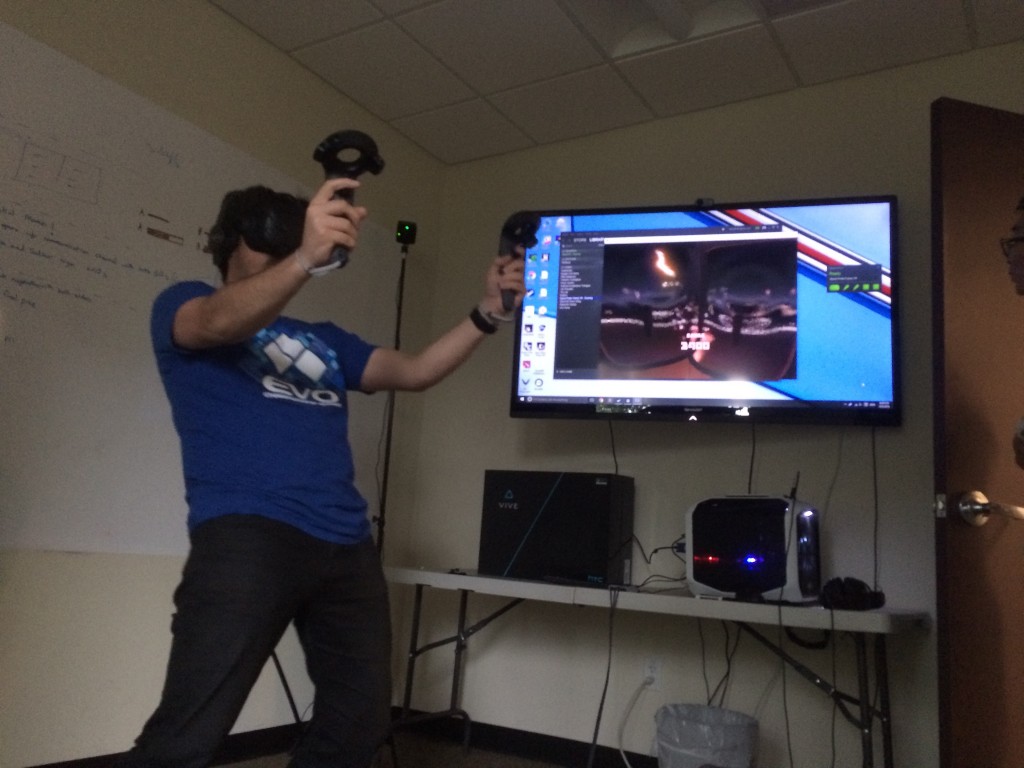In the last 2 weeks, both the Oculus Rift and HTC Vive came to consumers as the newest, fanciest virtual reality (VR) hardware available. Maybe you have had an opportunity to try out VR before, but I get the sense that this is the year and iteration on VR that really has the industry excited. Thankfully, my coworker Chris happened to pick up the HTC Vive and brought it into the office for all of us to try it out.
I will repeat the same thing you will hear from everyone else that explains nothing: you have to try it to understand how cool it is. I started out by playing Space Pirate Trainer, a game where Space Invaders-like drones float around you, and you have 2 blasters to shoot all of them down. The game has a few interesting mechanics, such as a shield you can “grab” off of your back, various blaster settings, and a Matrix-like bullet time to help dodge drone shots.
It didn’t take very long to get used to the entire setup. I haven’t played a lot of arcade shooters, but I have played enough to be comfortable with video game guns. Some of the mechanics were a little tricky to manage, such as using the thumb controls to switch blaster settings. Other than that, however, it felt totally natural to look around the world and move around to dodge and reposition. Of course, we had to watch Chris play to see how to crouch, lean around, and ride out a wave behind 2 shields.

I also tried out The Lab, where Valve put together a few demos for different VR interactions. The first one I hopped into was standing on a mountain looking out at the (pretty spectacular) landscape around me. There was a dog-like robot as well who would fetch sticks that I could pick up and throw. Most movement was restricted to an area of a couple feet, with a separate mechanic to teleport between different fixed points to move around.
The second demo was an Angry Birds-like setup in a warehouse, where I pulled back a slingshot to launch explosives into the stacks of crates to do as much damage as possible.
Having tried it out, I’m very excited to see where VR goes. I think the most interesting part about it is how well it works. I had assumed that there would be some sort of adjustment required to get used to VR, but I didn’t really encounter any technical difficulties in lag, distortion of images, or mismatches in my actions and how things worked in the world. Of course, I never really “forgot” that I was in a game, but I think I quickly got into a sense of flow that made interactions intuitive and natural. The biggest gap from real life was probably not having to walk around, but the implicit constraints of the games themselves made it largely unnecessary.
I’m excited to see what people do with VR in the next few months and years. I saw a nifty application in using VR to actually build the VR world in the Unreal Engine, but even that seems very self-directed. Smartphones changed consumer computing, but that still largely kept the screen-directed interface. With VR, voice recognition software like Siri, and gesture recognition like Leap Motion, we’re developing more natural interfaces for computing. I have been watching Star Trek: The Next Generation recently, and maybe our future looks like the holodeck than the bridge.